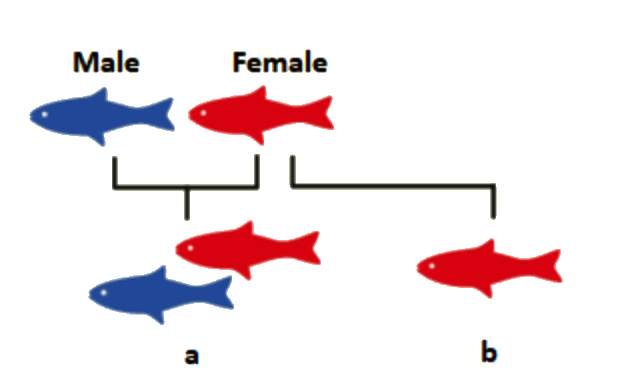Viviparity and Parthenocarpy
Step-by-Step Solution
1. Definition of Viviparity:
- Viviparity refers to a type of seed germination where the seeds germinate while still attached to the parent plant. This means that the seedlings start to develop inside the fruit itself before they detach from the parent.
2. Characteristics of Viviparity:
- In viviparous plants, the seeds do not enter a dormant phase; instead, they begin to grow immediately after fertilization.
- This phenomenon is commonly observed in certain environments, particularly in mangrove forests, where conditions such as low oxygen levels and high salinity affect the germination process.
3. Examples of Viviparity:
- A well-known example of a viviparous plant is the Rhizophora, which is a type of mangrove tree. These plants exhibit viviparity due to their adaptation to saline and anaerobic conditions.
4. Definition of Parthenocarpy:
- Parthenocarpy is the process of fruit formation without fertilization, resulting in the development of fruits that do not contain seeds. This means that the fruit develops even when pollination does not occur.
5. Characteristics of Parthenocarpy:
- In parthenocarpy, the absence of fertilization leads to the formation of seedless fruits. This can be advantageous for certain plants as it allows them to produce fruit without the need for pollinators.
6. Examples of Parthenocarpy:
- A classic example of parthenocarpy is the banana, which produces fruit without seeds due to this process.
Summary of Differences:
- Viviparity:
- Seed germination occurs while attached to the parent plant.
- Example: Rhizophora in mangrove forests.
- Parthenocarpy:
- Fruit develops without fertilization, resulting in seedless fruits.
- Example: Bananas.
- Viviparity refers to a type of seed germination where the seeds germinate while still attached to the parent plant. This means that the seedlings start to develop inside the fruit itself before they detach from the parent.
- In viviparous plants, the seeds do not enter a dormant phase; instead, they begin to grow immediately after fertilization.
- This phenomenon is commonly observed in certain environments, particularly in mangrove forests, where conditions such as low oxygen levels and high salinity affect the germination process.
- A well-known example of a viviparous plant is the Rhizophora, which is a type of mangrove tree. These plants exhibit viviparity due to their adaptation to saline and anaerobic conditions.
- Parthenocarpy is the process of fruit formation without fertilization, resulting in the development of fruits that do not contain seeds. This means that the fruit develops even when pollination does not occur.
- In parthenocarpy, the absence of fertilization leads to the formation of seedless fruits. This can be advantageous for certain plants as it allows them to produce fruit without the need for pollinators.
- A classic example of parthenocarpy is the banana, which produces fruit without seeds due to this process.
- Viviparity:
- Seed germination occurs while attached to the parent plant.
- Example: Rhizophora in mangrove forests.
- Parthenocarpy:
- Fruit develops without fertilization, resulting in seedless fruits.
- Example: Bananas.
Topper's Solved these Questions
- SEED DORMANCYBOOK - ICSECHAPTER - SEED DORMANCYEXERCISE - REVIEW QUESTIONS (IV Very Short Answer Type Questions (with answers))
20 Videos
- SEED DORMANCYBOOK - ICSECHAPTER - SEED DORMANCYEXERCISE - REVIEW QUESTIONS (V Short Answer Type Questions)
20 Videos
- SEED DORMANCYBOOK - ICSECHAPTER - SEED DORMANCYEXERCISE - REVIEW QUESTIONS (Fill in the blanks)
5 Videos
- SAMPLE QUESTION PAPER 5 BOOK - ICSECHAPTER - SAMPLE QUESTION PAPER 5 EXERCISE - Part - II Section - C
11 Videos
- SELF ASSESSMENT PAPER -1 BOOK - ICSECHAPTER - SELF ASSESSMENT PAPER -1 EXERCISE - PART II ( SECTION C)
6 Videos
Similar Questions
Knowledge Check
Viviparity refers to
AparthenocarpyBseed germinationCformation of seedlingDseed germination while still attached to parent
Differentiate between :
(a) Xenogamy and Geitonogamy
(b) Oviparous and Viviparous organisms
(c) Parthenogenesis and Parthenocarpy
View SolutionViviparity is found in
View SolutionDifferentiate between parthenogenesis and parthenocarpy.
View SolutionThe hormones which are found to be more effective in inducing parthenocarpy are
View SolutionWrite the hormone that induce parthenocarpy and also controls xylem differentiation
View SolutionObserve the diagram given below and identify a and b.

(1) a: Amphimixis , b : Parthenocarpy
(2) a: Amphimixis , b : Parthenogenesis
(3) a: Parthenocarpy ,b : Amphimixis
(4) a: Parthenogenesis , b: sexual reproduction
View SolutionGiven below are assertion and reason. Point out if both are true with reason being correct explanation (A), both are true but reason is not correct explanation (B), assertion is true but reason is wrong (C) both are wrong (D) . Assertion: In some species of asteraceae and poaceae, seeds are formed without fertilization Reason:Formation of fruit without fertilization is called parthenocarpy
View Solution
